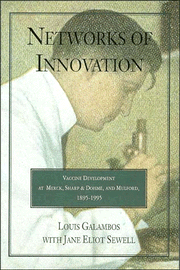Book contents
- Frontmatter
- Contents
- PREFACE
- 1 1894: “The foremost medical question of the day”
- 2 The Mulford Story
- 3 A Sharp & Dohme Interlude
- 4 The Virology Network and a New Program at Merck Sharp & Dohme
- 5 Hilleman's Innovations: First Phase
- 6 Dangerous Interlude
- 7 Transforming Bacteriology: A Second Phase
- 8 New Networks, New Leadership: The Hepatitis B Vaccines
- 9 Vaccine Innovation in the Nineties: New Strategies, New Opportunities, and Public Confrontations
- 10 Historical Perspectives on the Process of Innovation
- ACKNOWLEDGMENTS
- A WORD ABOUT SOURCES
- INDEX
- Plate section
10 - Historical Perspectives on the Process of Innovation
Published online by Cambridge University Press: 06 July 2010
- Frontmatter
- Contents
- PREFACE
- 1 1894: “The foremost medical question of the day”
- 2 The Mulford Story
- 3 A Sharp & Dohme Interlude
- 4 The Virology Network and a New Program at Merck Sharp & Dohme
- 5 Hilleman's Innovations: First Phase
- 6 Dangerous Interlude
- 7 Transforming Bacteriology: A Second Phase
- 8 New Networks, New Leadership: The Hepatitis B Vaccines
- 9 Vaccine Innovation in the Nineties: New Strategies, New Opportunities, and Public Confrontations
- 10 Historical Perspectives on the Process of Innovation
- ACKNOWLEDGMENTS
- A WORD ABOUT SOURCES
- INDEX
- Plate section
Summary
WHAT, THEN, does an historical perspective help us understand about the process of innovation in modern, science-based industries? First, we believe, it enables us to see more clearly the pattern of long cycles that characterizes this process. In the case of vaccines and antitoxins, there have been four long cycles in the past century: the original, bacteriology cycle, which began in the late nineteenth century and sustained innovation in biologicals into the 1920s; the virology cycle, which developed in the 1940s and 1950s and exerted a dramatic influence on innovation through the 1960s, the 1970s, and into the 1980s a third, less prominent long cycle in the 1960s and 1970s associated with the new bacteriology of polysaccharide capsules and a fourth, more prominent long cycle – grounded in recombinant DNA technology and the new molecular understanding of genetics – beginning in the late 1970s and exerting a major influence on innovation in the 1980s and 1990s.
The development of organizational capabilities followed a similar pattern, as the companies sought to develop capacities for innovation suited to the networks and related sciences and technologies of their respective eras. At the level of the network, the long cycles were a function of the basic nature of scientific and technical paradigms, which have a tendency to yield diminishing commercial opportunities over time. At the level of the firm, the long cycles were in part normal organizational phenomena of the sort explored in the sociology of bureaucracy. In the cases of Mulford, Sharp & Dohme, and Merck, each of the organizations had to acquire technical leadership of a relatively high quality to enable the company to understand and use the appropriate network information.
- Type
- Chapter
- Information
- Networks of InnovationVaccine Development at Merck, Sharp and Dohme, and Mulford, 1895–1995, pp. 241 - 252Publisher: Cambridge University PressPrint publication year: 1996



